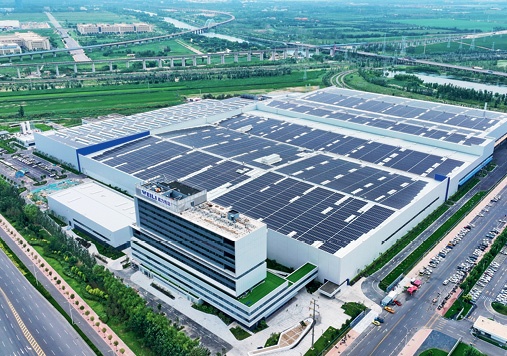
Wind turbines at the Yueliang Mountain Wind Farm in Xinying Township, Ningxia Hui Autonomous Region supply green energy, on August 16, 2025.
In his video speech to the United Nations Climate Summit held in New York on September 24, Chinese President Xi Jinping announced China’s new Nationally Determined Contributions (NDC) — the efforts taken by each country to reduce their emissions and adapt to the impacts of climate change.
China’s NDCs by 2035 will include reducing economy-wide net greenhouse gas emissions by 7-10 percent from peak levels; increasing the share of non-fossil fuels in total energy consumption to over 30 percent; expanding the installed capacity of wind and solar power to over six times the 2020 levels, in an effort to bring the total to 3,600 gigawatts; scaling up the total forest stock volume to over 24 billion cubic meters; making new energy vehicles the mainstream in the sales of new vehicles; expanding the National Carbon Emissions Trading Market to cover major high-emission sectors; and basically establishing a climate adaptive society.
China’s NDC has drawn widespread attention from the international community and carries significant importance for the global climate governance process.
Earlier this year, the Trump administration announced its withdrawal from the Paris Agreement and implemented a series of policies counteracting climate change efforts, severely disrupting global climate governance and creating significant uncertainty. The release of China’s new NDCs injects certainty and stability into the global climate governance process.

Yinchuan Weili Transmission Technology Co., Ltd. in Ningxia Hui Autonomous Region receives green electricity supplied by distributed photovoltaic systems on August 7, 2025.
.jpg) Proactive in Climate Governance
Proactive in Climate Governance China is a steadfast doer and a key contributor to global green development and climate governance, consistently submitting proactive and responsible commitments in past collective actions on global climate governance. During the general debate of the 75th session of the United Nations General Assembly in September 2020, Xi announced that China would scale up its NDCs by adopting more vigorous policies and measures, aiming to have CO2 emissions peak before 2030 and achieve carbon neutrality before 2060.
Xi has reiterated that “lucid waters and lush mountains” are invaluable assets, emphasizing the alignment of environmental protection with economic development. Climate change affects the fundamental matter of energy, which is vital to the national economy and people’s livelihood. Therefore, it is crucial to protect the climate while pursuing development, and to promote development while safeguarding the climate. In practical terms, the effectiveness of China’s ecological civilization concept lies in its implementation. However, climate action, particularly emission reduction efforts, must be both proactive and cautious, and the direction and pace of the transition to green development should align with international consensus on a just transition.
Guided by President Xi’s thought on ecological civilization, China has taken firm and effective climate actions, establishing the world’s largest and fastest-growing renewable energy system, and forming the world’s largest and most comprehensive new-energy industry chain. This year, its wind and solar power installation has already achieved the 2030 NDC targets ahead of schedule.
President Xi’s thought on ecological civilization embodies the ancient Chinese philosophy of “harmony between humanity and nature,” which lays the foundation for a scientific understanding of climate change. In addition, the Chinese principle of “unity of knowledge and action” further promotes proactive measures based on scientific understanding.
The key, however, to China’s domestic governance of climate change lies in effective implementation and practical exploration. In its climate change response, local pilot programs are important, such as pilot initiatives to develop low-carbon provinces and cities, carbon markets, climate change adaptation pilots, and zero-carbon parks. Pilot programs are designed based on policy objectives, and with guidance and practical adjustments, they are adopted nationwide.
Lankao County in central China’s Henan Province serves as a pilot for the rural energy revolution. After conducting thorough research, its practices have been implemented nationwide since 2023. At present, the county has 1.15 million kilowatts of installed renewable energy capacity, equivalent to 1.5 kilowatts per capita (approximately one wind turbine per village and photovoltaic panels installed on each household roof), sufficient to meet 96 percent of local electricity demand. Furthermore, through the integrated production and circular economy model of “gas, heat, electricity, and fertilizer,” the utilization rate of straw and livestock and poultry manure has exceeded 90 percent.

Wind turbines and photovoltaic panels operate synergistically, supplying a constant flow of green energy from Fengbuyu Industrial Demonstration Base in Yancheng, Jiangsu Province on May 28, 2025.
Green Diplomacy
China, from the perspective of building a community with a shared future for humanity, actively participates in and promotes international climate cooperation, strategically advancing its green major country diplomacy. While strengthening cooperative dialogue with developed countries, it also puts emphasis on enhancing collaboration with countries in the Global South.
Scientific understanding of climate change is the prerequisite and foundation for global climate action. Since the establishment of the Intergovernmental Panel on Climate Change (IPCC) in 1988, China has played an essential role in it, consecutively serving as co-chair of its First Working Group. Notably, Qin Dahe, an academician of the Chinese Academy of Sciences, who led the IPCC’s Third, Fourth, and Fifth Assessment Reports, once trekked across Antarctica and has been an active promoter of climate change among the public. Today, the number of Chinese scientists contributing to IPCC reports continues to grow. As a major developing country, China is deeply aware of the dilemma between emission reduction and development. However, under the guidance of President Xi’s thought on ecological civilization and his thought on diplomacy, China remains steadfast in upholding scientific understanding of climate change and the global climate governance system.
China has consistently promoted South-South cooperation in the field of climate change. In 2015, Xi announced an initiative which entails establishing 10 low-carbon demonstration zones, implementing 100 projects for climate change mitigation and adaptation, and offering 1,000 training opportunities on climate change in developing countries. Through South-South cooperation, China has provided other developing countries with financial, technical, and intellectual support to tackle climate change, thereby making South-South cooperation a key pillar in global climate governance. Over the past decade, China has achieved substantial progress in personnel training, project implementation, and industrial park development.

Hefei International New Energy Vehicle Exhibition sees a surge in visitors on October 3, 2025.
In addition, China is committed to advancing green development under the Belt and Road Initiative (BRI). It actively promotes a cooperative mechanism for green and low-carbon development within the BRI, assisting participating countries in enhancing environmental governance and improving people’s well-being. China has, to date, signed 54 South-South cooperation documents on climate change with 42 developing countries, carried out over 70 projects, and trained more than 2,300 personnel, helping these countries strengthen their capacity to address climate change. Since 2016, China has provided and mobilized more than RMB 177 billion in climate-related funding for other developing countries.
China also provides a substantial amount of wind power and photovoltaic equipment to the world, promoting the energy transition and offering green products and technological support to address global climate change. In recent years, China has supplied 70 percent of the world's photovoltaic modules and 60 percent of its wind power equipment. During the 14th Five-Year Plan period (2021-2025), the export of Chinese wind and photovoltaic products helped other countries reduce approximately 4.1 billion tonnes of carbon dioxide emissions.
China’s achievements can also be attributed to international cooperation. During the early development stages of its renewable energy equipment industry, the Clean Development Mechanism under the Kyoto Protocol offered invaluable support. In the future, global climate action, including efforts by China, will continue to require a favorable and open international environment.

African journalists visit the Talatan Photovoltaic Industrial Park in Gonghe County, Qinghai Province, which has the largest installed capacity in the world, on September 12, 2025.
Projects that Improve People’s Livelihood
Climate change is one of the most severe challenges facing the world today. Developing countries, on one hand, are heavily affected by climate change, on the other hand, they face numerous difficulties in their capacity to respond to it. During the 2025 China International Fair for Trade in Services, a high-level dialogue concerning climate leadership between China and climate-vulnerable countries attracted wide attention. Diplomats from Global South countries stationed in China, scholars from think tanks, and representatives from energy enterprises engaged in in-depth discussions on topics such as promoting prosperity for climate-vulnerable regions, achieving a just transition, and co-creating a sustainable future.
The “small and beautiful” projects (those that improve people’s livelihood) were proposed by China during the implementation of livelihood and green development assistance projects under the BRI. They represent environment friendliness and social inclusiveness, and are of significant importance for advancing the development of a Green Silk Road. Currently, cooperation on ecological and environmental protection is progressing steadily. A total of 46 ecological and environmental protection projects have been implemented, with environmental protection projects accounting for 35 percent of the total, among which animal protection projects represent 26 percent.
Clean energy projects are actively guiding local economic transformation in participating countries. China has conducted 910 small-scale green energy cooperation projects with 113 countries and regions, 86 percent of which are concentrated in Asia, Africa, and Latin America. Following rapid growth, such cooperation has expanded from being predominantly hydroelectric to a diversified mix including solar, photovoltaic, and wind energy.
Technological advancements have significantly reduced the cost of climate action, and the low-carbon transition has become a prevailing trend. In promoting these projects, an increasing number of Chinese enterprises are getting involved, including private companies and female-led ones.
The United Nations Industrial Development Organization reported the story of Li Xia, a Chinese woman who as founder and CEO of a technology company based in Shenzhen, led her team to invent a portable photovoltaic lamp. She has since been deeply engaged in the African market for 15 years, aiming to lighten up Africa with solar power. Today, she not only provides clean energy products to impoverished people living in areas without electricity, but has also transformed a commercial foreign trade company into a social enterprise, achieving a win-win outcome for economic, social, and environmental benefits.
China’s proactive actions in addressing climate change provide other developing countries with new options for achieving green development. These actions not only robustly advance China’s own climate change response efforts, but also promote global climate governance, effectively tackling climate challenges and demonstrating China’s leading role in global climate governance. 
SUN ZHEN is former first-level inspector of the Department of Climate Change at the Ministry of Ecology and Environment.